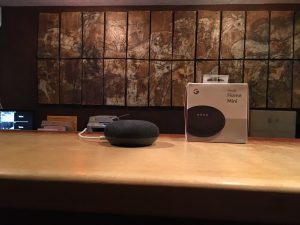Today’s post doesn’t have a lot to do with databases. But it relates to a recent SQL Saturday. What follows is the summary of a two-week adventure of training a Google Home Mini to become a hotel concierge.
SQLSaturday
I was lucky to receive a winning ticket at the raffle at the recent Albuquerque SQL Saturday on May 5th. Jamey Johnston stepped up like many other volunteers and presenters to donate a Google Home Mini[1] for the raffle. Ironically I had just been pricing them this month so I could give one to a hotel where I moonlight. I missed Jamey’s session but I heard from a friend that he gave an amazing presentation.
The goal.
So, six of us work the front desk during the week at the hotel where I moonlight. Hospitality happens to be a good side gig in Santa Fe since the only work in town centers around government and tourism, there’s not much tech work here. Hotel work is good because every day seems different and I enjoy the challenge of helping guest’s love their stay in Santa Fe and sharing people’s travel stories with the same passion that I enjoy my own travels.
At the front desk, we are asked many questions while multitasking with the telephone and the reservation systems. Many of the questions we answer follow a repeated theme: “How far is it to Denver?” “The Grand Canyon?” “Phoenix?” “How long will that take?” “What is the phone number for Tecolote?” “Enterprise Car Rental?” To be able to answer these questions simultaneously as we’re clicking our way through the reservation systems is priceless.
With this goal in mind, I set out over four weekend shifts to train the little gadget for concierge duties.
The setup.
1. Using a group account. We created a new Google account for the mini, a “butler” account basically. This is an important difference between the usual use case for this device. Using our main front-desk e-mail account may have exposed sensitive e-mails, contacts, and calendar events to random inquiry. Likewise, using a personal account would have been similarly problematic.
2. A reused trac phone. The Google Home Mini requires the Google Home app on a mobile device. I had a $10 left-over LG phone from my Android Studio app-writing days. The sim card was inactive, and wasn’t necessary, as the only network requirement was wifi, not cellular. The old LG was running Android version 4.4.2 which still works fine as the proxy device for the Google Home App.
3. Taking over the fax. We had a good laugh, as well as some frustration over this issue when she took over the DHCP address for the fax machine. We laughed about the mini taking over the world, starting with the fax machine and any other devices that stood in her way. It was actually frustrating because on day one we needed to print to the fax, and the only way to do so was to shut off the mini and clear the arp cache on the PC. It was a problem we had in the past with other devices taking over the fax. This event actually forced us to finally deal with the problem, and come up with a solution. In the past, we were inadvertently looking at the DHCP configuration on a misconfigured wifi router as the original cause of the problems. But upon closer inspection, we found out that setting a reservation for the fax machine in the DHCP service on the domain controller was the solution to the problem. The fax would shut down its ethernet interface for days when we wouldn’t use it to print thus causing the DHCP service on the domain controller, not the router, to reissue the ip address to the next new device.
The outcome.
The Mini has five written goals on the box and were experimenting with most of them:
The “Know it all” — Google’s AI is pretty good here. She seems tuned to efficiently answer many of the common questions we receive about businesses and places.
The “Day tackler” — We’ve still got some experiments to do here. I’ve experimented with having her help out with room wake-up call reminders, but she seems to get the wrong day on some of the wake-up calls, and reminders entered manually on her calendar go unreminded.
The “Hands-free caller” — She’s doing a good job here. The voip speaker calls are pretty clear, and as long as we don’t touch the side during a call she won’t hang up on us. Because of the integration with her Google contact list she can call me up by my first name. But, no-one else is jumping on the bandwagon to add their contact info to her contact list. I’ve tried to configure the device to use the front desk phone number, but can’t get the pbx system to take a confirmation text message to finish configuring the phone number. So the caller ID still comes up as unlisted “No Caller ID” on the receiving end. We’re even considering using her voip functionality for guests to call us immediately when we have to leave the front desk to take care of something on the property.
The “Entertainer” — The Spotify integration is pretty sweet, and makes the long nights a little more pleasant. I’ve been e-mailing my Spotify playlists to her account.
The “Home controller” — No immediate plans here … but it might be amusing to tell her to turn on a no vacancy sign, or do something on the other side of the property.
I’ll update this post as we find amusing use cases. Thanks again Jamey and the SQL Server community.
[1.] In a group discussion this past Saturday I learned that it’s a sign of the times that the smaller SQL Saturdays like ours will need member donations in the future since the larger vendors haven’t been finding a return on their investment outside of major metropolitan cities.

